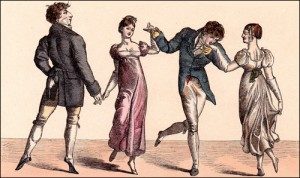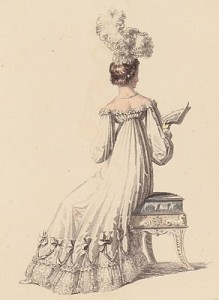 I admit I’ve been out of the dating scene for (ahem) a few years now. However, from what my single friends tell me, not much has changed since I was dated. In today’s world a man asks out a woman, (or if she’s braver than I ever was, she asks him out). They might meet online, or be introduced by a friend, but eventually they end up on that first date. It might be dinner or drinks or just coffee (in my case, hot cocoa). It might involve a movie or miniature golf or a museum. It might even occasionally include another couple but it never involves parents or chaperones, and no one thinks anything of an adult man and a woman being alone together in a car or a house.
I admit I’ve been out of the dating scene for (ahem) a few years now. However, from what my single friends tell me, not much has changed since I was dated. In today’s world a man asks out a woman, (or if she’s braver than I ever was, she asks him out). They might meet online, or be introduced by a friend, but eventually they end up on that first date. It might be dinner or drinks or just coffee (in my case, hot cocoa). It might involve a movie or miniature golf or a museum. It might even occasionally include another couple but it never involves parents or chaperones, and no one thinks anything of an adult man and a woman being alone together in a car or a house.
Dating in Regency England was very different. For one thing, it was called courting or wooing. But most importantly, a young lady of good breeding who wished to keep her reputation pristine so she would be a candidate for marriage never, ever put herself alone with a man. (The double standard is, of course, that the man was expected to have “sown his wild oats” and could have a very sullied reputation and still be considered a good match if he were wealthy and well-connected enough.) Therefore, courting was a very public affair.
First, they needed an introduction by a mutual friend before conversing. They often met at balls which were THE places to meet those of similar social backgrounds, but they might also meet at a dinner party, soiree, musicale, or even the opera or the theater.
If the man wished to get better acquainted with the lady he’d met, he might send her flowers the next day (but never gifts or letters), and later pay a visit upon the family during their “at home” hours where her mother or aunt or other chaperone would be present. He might take her for a stroll in one of the walking parks, with a chaperone close at hand. He might even take her riding on horseback or in an open carriage—open being the operative word since riding in a closed carriage could ruin her reputation as quickly as being alone in a house with a man.
 Courting could be short or take place over a long period of time. At a ball, if she refused to dance with any other man but him, she basically announced to the world that they were engaged. If she danced with him more than twice in one night, everyone assumed she was either engaged to him or was “fast,” a terrible label for a proper young lady. If he spent a lot of time with her to the point where people began to notice how much they were together, public opinion placed them as engaged. If he failed to make an offer of marriage for her, people said he had failed to come up to scratch and shook their heads and wondered if she were unsuitable or if he were. Either way, the couple’s reputations suffered. At that point, their only option would be to marry or live with tainted reputations. Depending on his status, his reputation would probably recover but hers would likely remain tainted.
Courting could be short or take place over a long period of time. At a ball, if she refused to dance with any other man but him, she basically announced to the world that they were engaged. If she danced with him more than twice in one night, everyone assumed she was either engaged to him or was “fast,” a terrible label for a proper young lady. If he spent a lot of time with her to the point where people began to notice how much they were together, public opinion placed them as engaged. If he failed to make an offer of marriage for her, people said he had failed to come up to scratch and shook their heads and wondered if she were unsuitable or if he were. Either way, the couple’s reputations suffered. At that point, their only option would be to marry or live with tainted reputations. Depending on his status, his reputation would probably recover but hers would likely remain tainted.
Such courting practices may sound rigid and even sterile to the modern-day woman, but I think it leaves so much open. For one thing, they relied on witty conversation rather than getting physical to get to know each other. And since the courting practices were pretty predictable, a man had to use creativity to impress a lady.
Once he felt secure she returned his affections, the gentleman would make an appointment with the girl’s father and formally ask for her hand in marriage. His income would be scrutinized and they would draw up a prenuptial agreement called a marriage settlement which included her pin money, dress allowance, jointure, and other ways he’d provide for her, as well as what dowry would go to the man. With all that settled, the father would break the news to the girl and the wedding preparations would commence.
 My goal as Regency romance author is to keep in mind these social customs known as ‘manners and mores’ and yet find unique ways for my hero and heroine to meet and fall in love. I enjoy creating a unique twist on acceptable courting, throwing lots of obstacles in the way of their happily ever after, and revealing the final, happy, triumphant ending. That doesn’t make me a hopeless romantic, it makes me a hopeful romantic.
My goal as Regency romance author is to keep in mind these social customs known as ‘manners and mores’ and yet find unique ways for my hero and heroine to meet and fall in love. I enjoy creating a unique twist on acceptable courting, throwing lots of obstacles in the way of their happily ever after, and revealing the final, happy, triumphant ending. That doesn’t make me a hopeless romantic, it makes me a hopeful romantic.
My tagline is ‘Believe in happily ever after’ because I do believe in it. Do you believe in happily ever after?

Was love and courtship pretty much the same in the US? The 1910s are a little hazy on dating protocol. Though your comment about the number of dances is an “aha” as to how my uncle treated his favorite girlfriend. It may have been that he didn’t want people to assume engagement.
I also love coming up with ways of my character’s meeting ion spite of the rules=)
I’m not an expert at Edwardian era manners and mores, but from what little I do know, dating and courtship had changed very little. The 1950’s seem to be when the most change happened.